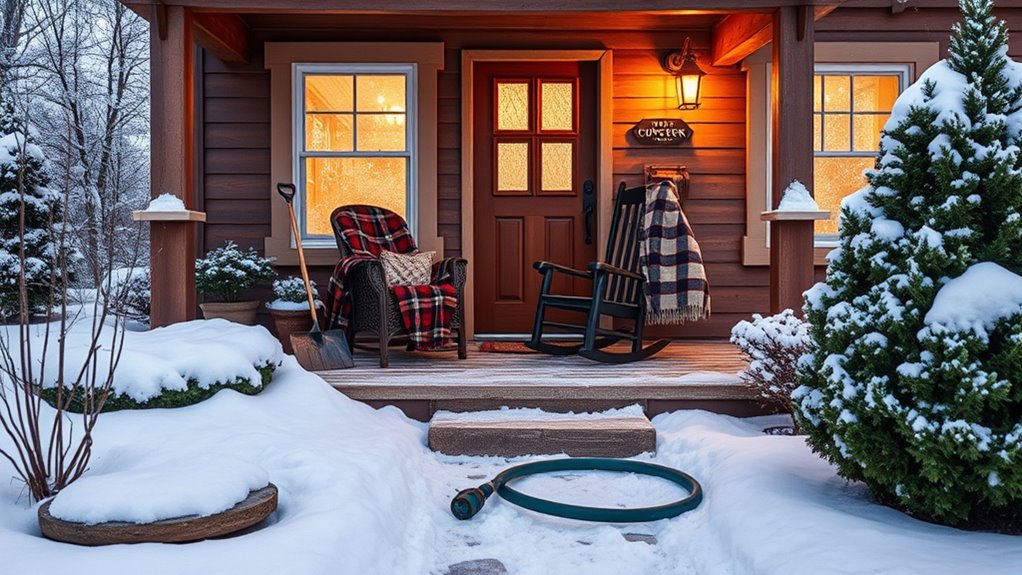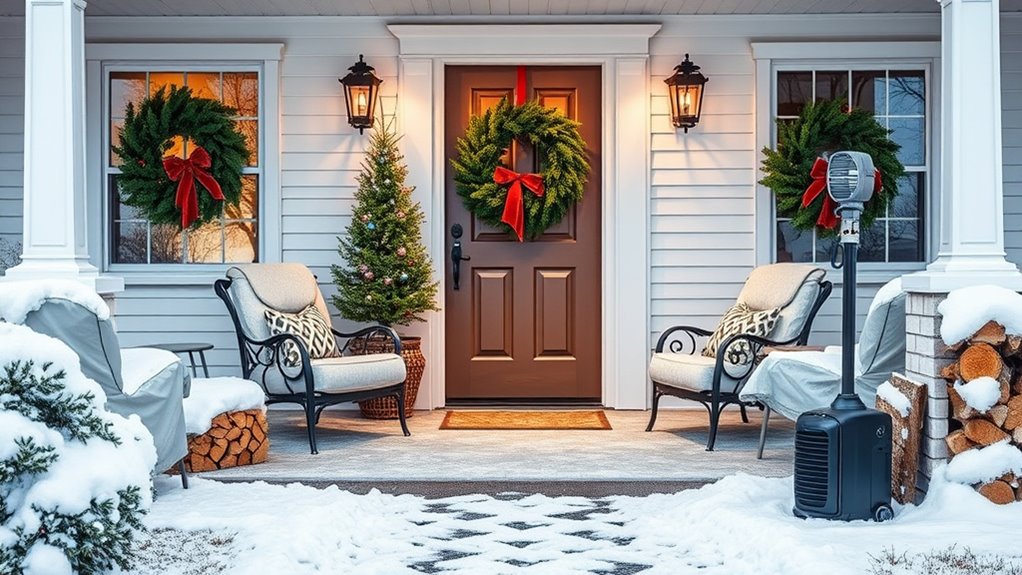To prepare your home for winter, start by upgrading insulation in your attic, walls, and floors to keep heat inside. Inspect your roof for damage and clean gutters to prevent ice dams. Seal gaps around windows and doors to stop drafts and improve energy efficiency. Trim tree branches that could fall and cause damage. Finally, set up emergency supplies in case of power outages. Continuing with these steps will help you stay warm, safe, and ready for the cold months ahead.
Key Takeaways
- Upgrade attic, wall, and floor insulation to reduce heat loss and improve energy efficiency.
- Inspect and repair the roof, shingles, and flashing to prevent leaks and water damage.
- Seal gaps around windows and doors, and maintain heating systems for reliable warmth.
- Clear gutters and trim tree branches to prevent ice dams and roof damage during storms.
- Prepare an emergency kit and winter supplies to ensure safety during power outages and cold weather.

As winter approaches, it’s essential to get your home ready to withstand cold temperatures and potential storms. One of the most effective ways to do this is by focusing on insulation upgrades. Proper insulation helps keep the warmth inside your home, reducing heat loss and lowering energy bills. Check your attic, walls, and floors for gaps or areas where insulation may be inadequate. Upgrading your insulation can make a significant difference in maintaining a comfortable indoor temperature and preventing drafts. If you’re unsure about the current state of your insulation, consider consulting a professional to assess and recommend the best options for your home.
Upgrade your home insulation now to stay warm and reduce energy bills this winter.
Alongside insulation, roof inspections are vital before winter sets in. Your roof is your home’s first line of defense against snow, ice, and strong winds. Regular inspections help identify loose or missing shingles, damaged flashing, or any signs of leaks. Addressing these issues early prevents water intrusion and further damage during heavy snowfall or storms. Pay close attention to areas around chimneys, vents, and skylights, as these are common points of vulnerability. If you notice any problems during your inspection, don’t delay repairs; doing so can save you from costly repairs later and ensure your roof remains sturdy throughout winter.
In addition to insulation and roof health, consider sealing gaps around windows and doors. Cold air slipping through cracks can make your home uncomfortable and increase heating costs. Weatherstripping and caulking are simple, cost-effective solutions that improve energy efficiency. Also, check your heating system—whether it’s a furnace, heat pump, or boiler—and schedule maintenance if needed. A well-maintained heating system runs more efficiently, providing reliable warmth when you need it most.
Don’t forget to clear your gutters and downspouts. Clogged gutters can lead to ice dams, which cause water to back up into your home and damage the roof and walls. Remove leaves and debris, and ensure water flows freely away from your foundation. Also, trim back any tree branches that could fall on your roof during a storm, preventing additional damage. Incorporating home organization strategies can help you efficiently manage your winter supplies and keep your home safe and clutter-free.
Finally, prepare an emergency kit with essentials like blankets, non-perishable food, water, and batteries in case of power outages. Stock up on winter supplies and plan for alternative heat sources if necessary. By taking these proactive steps—upgrading insulation, inspecting and repairing your roof, sealing drafts, maintaining your heating system, and preparing for emergencies—you can enjoy a warm, safe winter while minimizing potential headaches caused by winter weather. Preparing now guarantees your home is resilient, comfortable, and ready to face whatever winter has in store.
Frequently Asked Questions
When Should I Start Winterizing My Home?
You should start winterizing your home before the first cold snap hits, ideally in late fall. This ensures you’re prepared for winter storm preparedness and can prevent costly damage. As you get ready, consider holiday decorating tips that keep safety in mind, like avoiding overloading circuits or placing decorations away from heat sources. Starting early gives you ample time to secure your home and enjoy a cozy, stress-free winter season.
How Can I Prevent Frozen Pipes Effectively?
To prevent frozen pipes, you need to focus on freeze prevention. First, insulate your pipes with pipe insulation to keep them warm. Then, let your faucets drip slightly to maintain water flow. Open cabinet doors to allow warm air to reach pipes in cabinets. Additionally, keep your thermostat consistent, especially during cold snaps. These steps work together to reduce the risk of pipes freezing and bursting.
What Are Cost-Effective Ways to Insulate My Home?
To insulate your home cost-effectively, start with window treatments like thermal curtains or plastic window coverings to reduce heat loss. Next, add attic insulation, which provides excellent thermal resistance and prevents heat from escaping through the roof. These simple upgrades are affordable, easy to install, and make a noticeable difference in keeping your home warm during winter, saving you money on heating bills.
How Do I Choose the Best Weather Stripping?
Picking the perfect weather stripping starts with evaluating draft sealing needs. You want door insulation that’s durable, flexible, and tailored to your gaps. Look for options like foam, vinyl, or rubber, considering their sealing strength and ease of installation. Measure precisely to match your door’s dimensions. When you choose wisely, you’ll prevent drafts, improve insulation, and keep your home warm and welcoming throughout winter’s worst.
Are There Eco-Friendly Winter Preparation Options?
You’re wondering about eco-friendly winter prep options. Consider installing solar panels to harness renewable energy and reduce your carbon footprint. Plus, incorporate composting tips to manage organic waste sustainably throughout the season. These eco-conscious choices help lower your environmental impact while keeping your home warm and efficient. By integrating solar and composting into your winter plan, you prioritize sustainability without sacrificing comfort.
Conclusion
As you finish preparing your home for winter, remember that a well-warmed house offers comfort and safety. While the chilly winds may threaten to seep in, your efforts create a cozy sanctuary. Just as a sturdy roof shields you from storms, your preparations protect you from the harshest cold. Embrace the peace of knowing you’re ready—because in winter, feeling secure is worth every effort. Stay warm, stay safe, and enjoy the season ahead.








